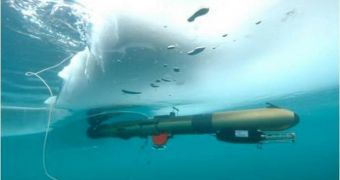Scientists say that next month will see a series of investigations being conducted in the ice-covered Antarctic Ocean with the help of an autonomous underwater vehicle (AUV).
The explorations robot is capable of remaining submerged for prolonged periods of time, and has the ability to conduct studies in environments with hazardous and perilous conditions.
One of the most important lines of investigation for the new study will be analyzing the Antarctica ice shelf from underneath, and also to take a closer look at the ice-covered ocean at the South Pole.
The icy waters around the continent are changing rapidly with global warming, but they are also exhibiting large levels of seasonal variations.
Experts want to use the AUV to retrieve samples from these waters, and also to use the AUV to measure and map the ice caps and seafloors at its location, Our Amazing Planet reports.
The research is important considering that current climate models predict a devastating ice cap melt in Antarctica. By 2100, data show that 33 percent of the sea-based ices will disappear.
This means that there would be fewer barriers stopping land-based ice shelves from slipping into the ocean, and contributing significantly to rising sea levels around the world.
Related to this issue, the underwater robot will also look at how ice shelves on the shorelines contribute to the mixing of seawater in areas adjacent to the Antarctic.
“Under-ice datasets will allow us to better understand ice-ocean interactions and provide valuable information for climate modelers,” explains researcher Craig Stevens.
He was a postdoctoral researcher at the University of British Columbia (UBC) in Vancouver, Canada, when the work was conducted, but he is now based at the New Zealand National Institute for Water and Atmospheric Research.
“Few labs in the world are able to investigate the spatial variability of ocean properties under ice,” adds UBC study team member Bernard Laval.
“Findings from this study will be unique as there have only been a few under-ice AUV deployments globally, even fewer in the vicinity of ice shelves,” he adds. This robot is called UBC-Gavia, he adds.
The machine will be running missions from October 17 through November 12. it is fully equipped with a suite of scientific instruments, which will allow it to conduct complex investigations.

 14 DAY TRIAL //
14 DAY TRIAL //